This Thai Kabocha Squash in coconut milk dessert is a delicious sweet treat using just five ingredients. This delicious Thai dessert uses coconut milk and palm sugar for flavoring. It is a light and creamy recipe, perfect for any time of year. Simple and easy Thai dessert!
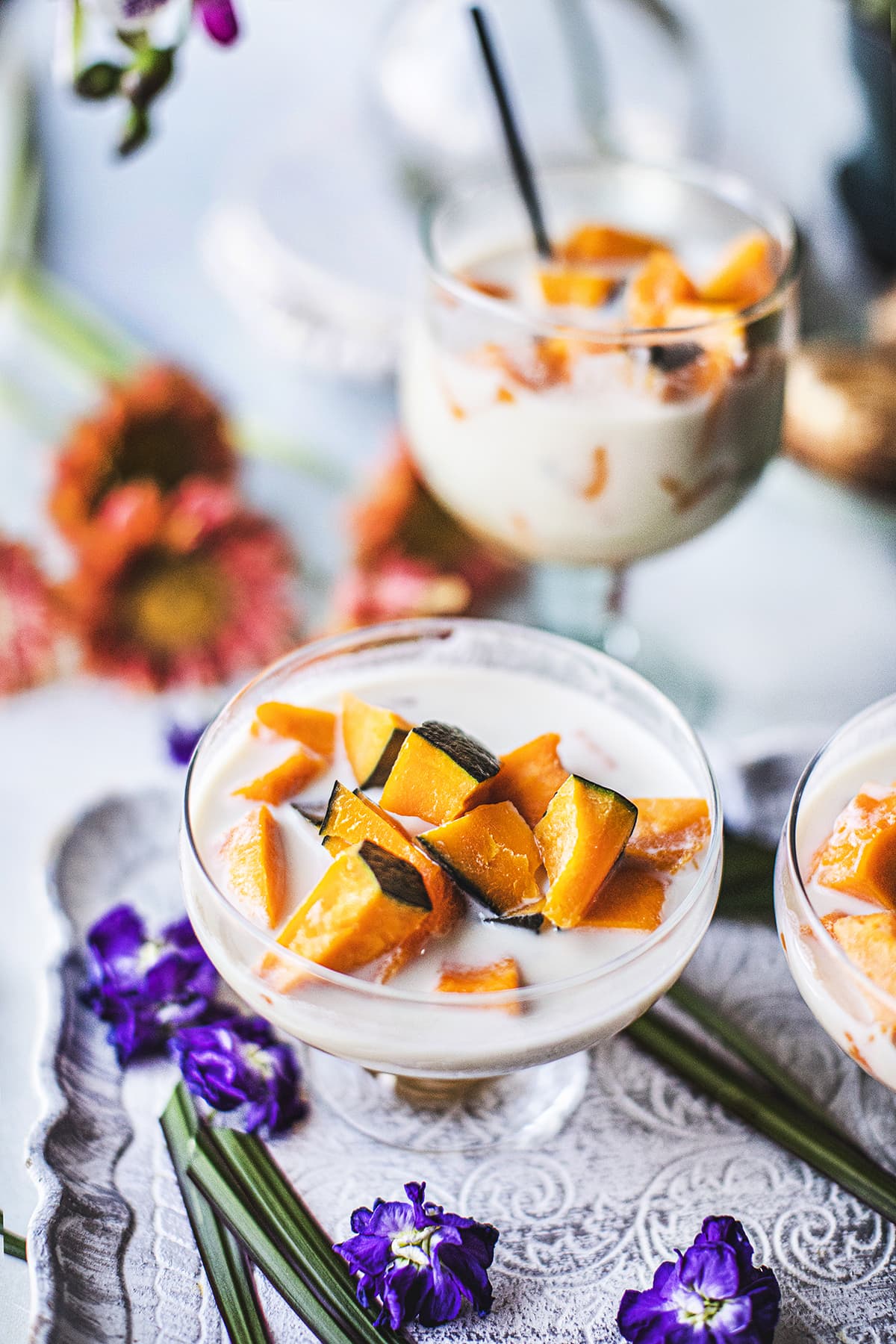
For more Kabocha recipes, try these popular recipes: Thai red curry with kabocha squash, Thai pumpkin custard, Thai pumpkin custard (Sankaya Fak Tong) and Kabocha squash stir fry and Kabocha squash soup.
Jump to:
- Why You'll Love This Recipe
- What is Thai Kabocha Squash Coconut Milk Dessert?
- Thai coconut milk dessert vs Thai pumpkin custard
- Ingredients for Thai kabocha coconut dessert
- Substitutes for Thai Kabocha squash dessert
- How to make Thai Kabocha Squash coconut dessert
- Kitchen notes
- Helpful Kitchen Tools for this Recipe
- What to Serve With Gaeng Boud Faktong
- Variations
- Substitutes
- Storage
- Frequently Asked Questions
- Conclusion
- More Thai Recipes You'll Love
- Thai Kabocha Squash in Coconut Milk Dessert
This sweet kabocha squash dessert recipe is a lesser-known Thai dessert that only a few seem to know about. It’s an unassuming dessert that some may not even want to try, especially with a pumpkin.
For those who are adventurous, your curiosity will be greatly rewarded. The naturally sweet and creamy texture of cooked Kabocha squash absorbs coconut milk's sweet and silky taste, making this dessert one of the most satisfying sweet treats.
Why You'll Love This Recipe
- A harmonious blend of flavors: The combination of kabocha squash, coconut milk, and palm sugar creates a delightful harmony of tastes that balances sweetness and creaminess.
- Easy to make: This dessert can be easily prepared with simple step-by-step instructions, even for novice cooks.
- Unique and exotic: Experience the authentic flavors of Thailand with the infusion of kabocha squash, palm sugar, and coconut milk.
- Versatile: Serve it warm or chilled. Add crushed or shaved ice for an extra fun texture! This dessert can be enjoyed in any season and for any occasion.
- The kabocha squash is full of healthy nutrients, creating a perfect balance of indulgence and healthfulness in one dish. Read more about what Kabocha squash is and how to cut it here.
What is Thai Kabocha Squash Coconut Milk Dessert?
Thai Kabocha Squash dessert with coconut milk is a traditional Thai delicacy called Kong Wan Boud Faktong. It is a delicious Thai dessert made with kabocha squash with sweet and creamy flavors from the kabocha squash and coconut milk.
The kabocha squash is cooked until soft and blended with coconut milk sugar to create a smooth and flavorful dessert. It is often served warm and can be enjoyed on its own or with a scoop of ice cream.
Boud Fak Tong is a popular dessert in Thailand and is perfect for those with a sweet tooth.
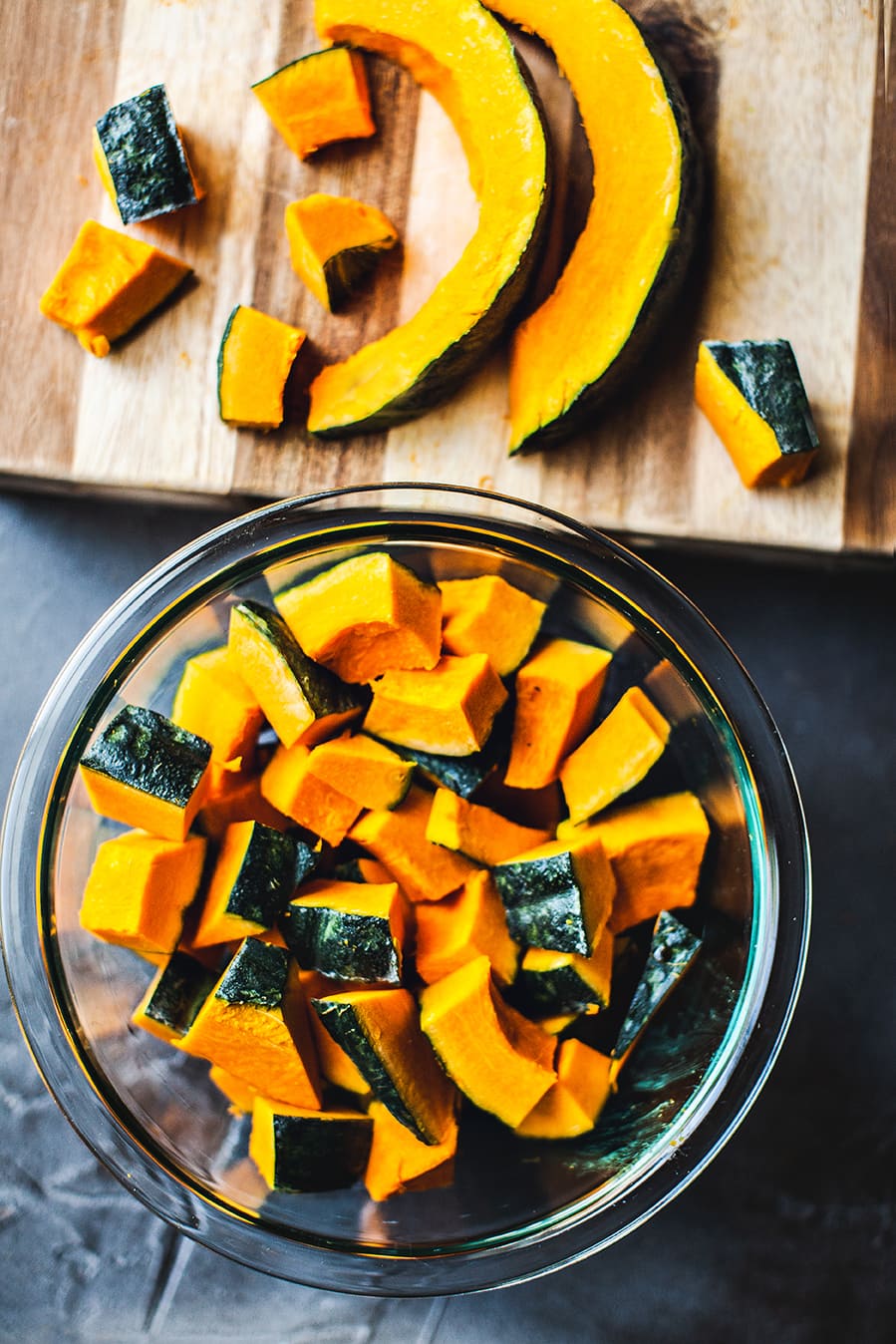
Thai coconut milk dessert vs Thai pumpkin custard
Thai coconut milk dessert and Thai pumpkin custard are both delicious and popular desserts in Thailand. However, there are some key differences between the two.
First, Fak Tong in Thai means Kabocha squash, and both desserts are made with this type of pumpkin, so they both use the Thai name Fak Tong in their names.
One main difference is the main ingredient used in each dessert. This Thai pumpkin in coconut milk dessert, also known as Kaeng Buat Fak Thong, is made with sliced, soft-boiled kabocha squash.
On the other hand, Thai pumpkin custard, also called Sankaya Faktong, is made with creamy coconut custard and then steamed inside the kabocha pumpkin.
Another difference is the texture of the desserts. Thai coconut milk dessert has long, thin pieces of boiled kabocha soaked in sweetened coconut milk and palm sugar syrup. Due to steamed egg yolk and pumpkin, Thai pumpkin custard has a creamy texture.
In terms of preparation, Thai coconut milk dessert is typically boiled, while Thai pumpkin custard is steamed. The steamed pumpkin dessert is made by placing the custard mixture inside or on top of the pumpkin. Then, it's steamed to perfection.
Both pumpkin desserts are loved by many people and are considered the favorite traditional Thai desserts. However, with its creamy and smooth texture, Thai pumpkin custard is often preferred for its rich and indulgent taste.
On the other hand, the Thai coconut milk dessert, with sliced squash pieces, has a slightly firmer texture and offers a different and satisfying experience.
Ingredients for Thai kabocha coconut dessert
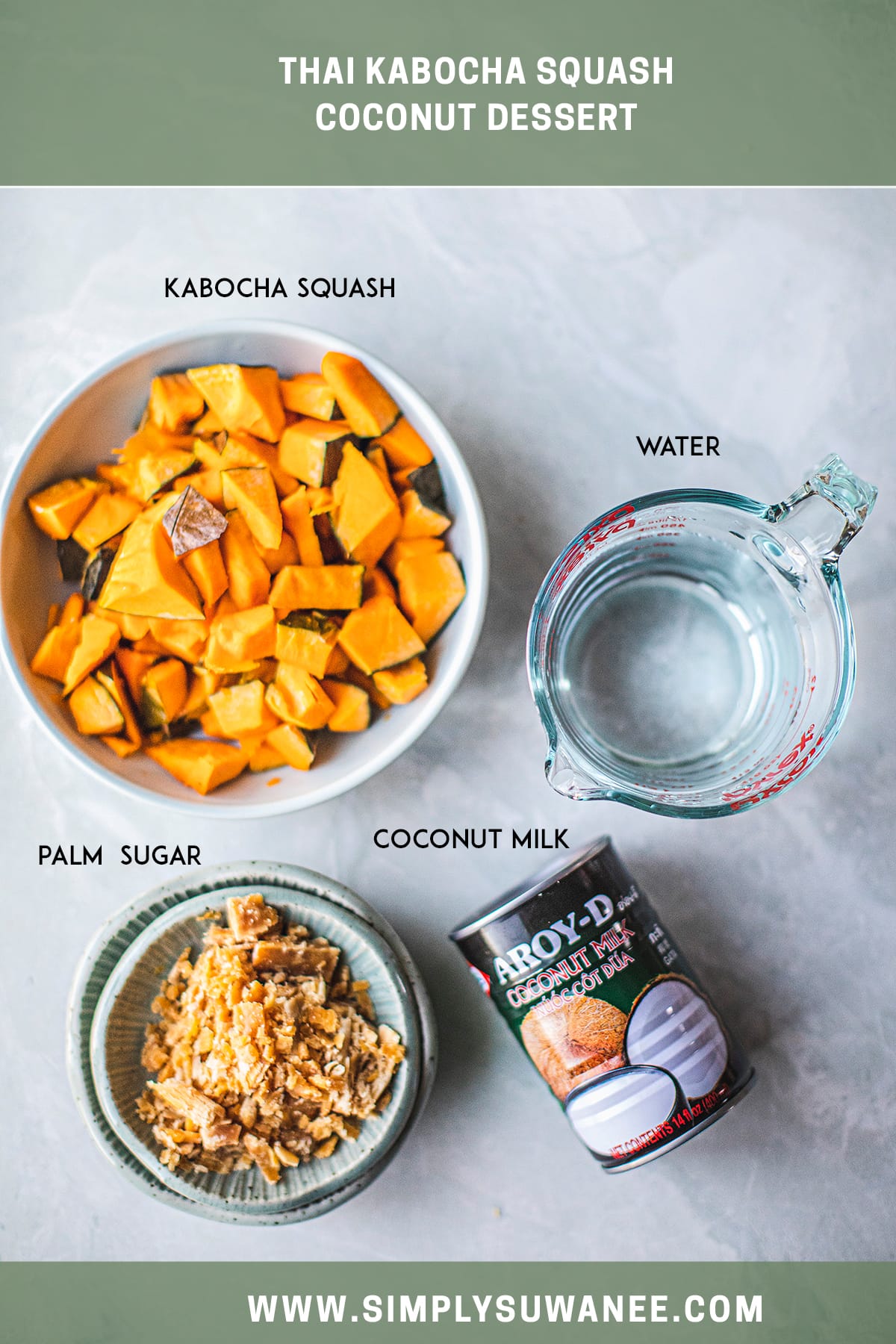
This Thai Gaeng Boud Faktong recipe is amazingly simple, using just a handful of ingredients. The cooking also doesn’t take long. The most involved part of the recipe will be prepping and cutting the kabocha squash before cooking it on the stove stop.
- Kabocha squash. Also called Japanese pumpkin. Extra tip- You can find them almost all year round at most Asian markets! You don't have to wait until late summer or fall for the kabocha squash to show up. They last a long time, too—sometimes months! Especially if they are kept in the refrigerator or a cool place. Read about what Kabocha Squash is here.
- Coconut Milk. Use unsweetened full-fat coconut milk and Thai brands, preferably. Chao Koh or Aroy-D are my go-to brands.
- Palm sugar. You can find palm sugar in most Asian markets. It comes in many different forms. Some in small, medium, or large half-circle pucks. Some are soft and melted in a plastic tub, and some are sealed tight like a paste in plastic bags. You will find some form of palm sugar in your local Asian markets. To learn more about this ingredient, read what palm sugar is here.
- Water. Water is mixed with coconut milk to create a creamy base for this dessert.
- Salt. Optional. To help balance out the sweetness of the dessert a little bit.
Substitutes for Thai Kabocha squash dessert
The following sweet and starchy vegetables can substitute this classic Thai dessert. Experiment and leave me a comment below with our results! I'd love to know!
- Thai bananas or young bananas that aren’t as ripe yet
- Calabaza pumpkins
- Sweet potatoes
- Japanese sweet potatoes
- Ube potatoes
- Taros
How to make Thai Kabocha Squash coconut dessert
Step 1. Cut the Kabocha squash into 1½-2-inch bite-size pieces. You can leave the skin on as it’s perfectly edible, and that’s how it would be eaten in this traditional Thai dessert.
Step 2. Warm up a medium-large pot or saucepan over medium heat, combine the sliced kabocha, coconut milk, and water. Bring the mixture to a gentle boil and cook the squash until tender, about 10-15 minutes.
Carefully test with a fork to see if the kabocha is tender enough for eating.
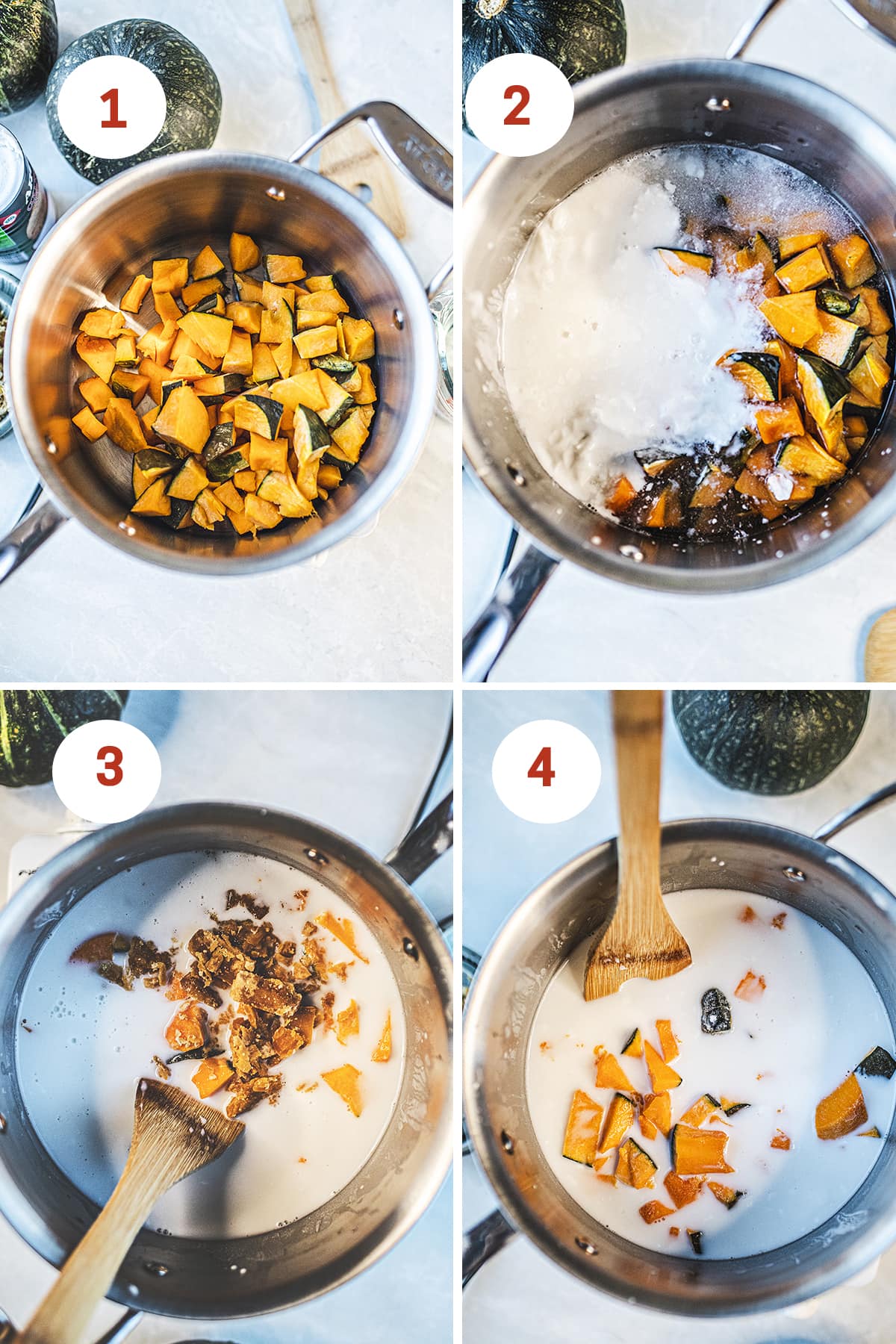
Step 3. Add the sugar and salt and gently stir to not break the squash until the palm sugar dissolves.
Step 4. Remove from the stove and let cool before serving. This dessert is typically served warm or at room temperature.
Kitchen notes
- The squash's skin is typically left on because it gets tender when cooked. The skin helps hold the kabocha's soft and creamy meat together during cooking. You can leave the skin on the squash or peel it off.
- It is best to serve warm or at room temperature. Overnight is fine, too, but know that the squash will get a bit mushy or creamy if used the next day. It's very good, but the squash will become a light puree texture, adding to the dessert's creaminess.
- You can use brown or granulated sugar if you can’t find palm sugar. Know that your dessert will be sweeter if you do not use palm sugar.
- Add crushed ice to the dessert bowl before serving for a chill and fun dessert. This is incredibly refreshing during the summer months.
Helpful Kitchen Tools for this Recipe
- Medium pot: For cooking and simmering the dessert.
- Sharp knife: Cut the pumpkin into large pieces and remove the seeds.
- A heavy-duty cutting board for cutting the kabocha squash.
What to Serve With Gaeng Boud Faktong
- Enjoy this creamy delight as a sweet dessert after a Thai feast.
- Add a scoop of vanilla ice cream as a splurge!
Variations
- use coconut cream for a more rich and creamy dessert.
- Add pandan or vanilla extract for extra fragrance and aroma in the dessert.
Substitutes
- Replace palm sugar with coconut, white, or monk fruit as substitutes.
Storage
- Store any leftover dessert in an airtight container in the refrigerator for up to two days.
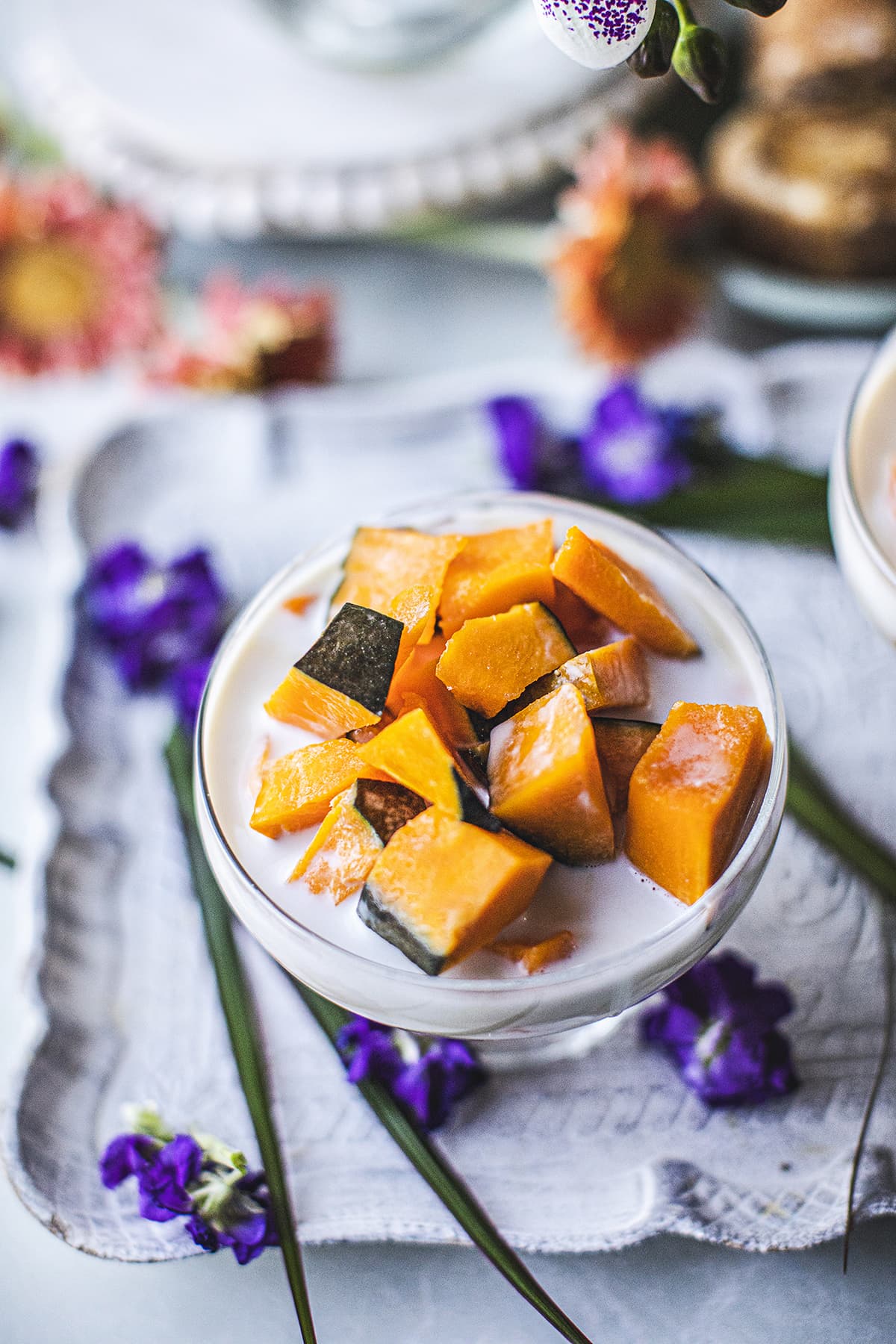
Frequently Asked Questions
No. This Thai dessert requires large pumpkin pieces for its unique texture and experience. A pumpkin puree will not work.
Yes, you can sweeten the dessert with brown sugar or other sugar. Monk fruit, coconut sugar, and light brown sugar are excellent options.
You can enjoy it both ways! It's delicious when served warm but equally delightful when chilled.
Conclusion
Thai Kabocha Squash, a Coconut Milk Dessert, is a delightful journey into the heart of Thai cuisine. With its rich and creamy texture, this dessert is a true showcase of the unique flavors of Thailand.
Whether you're a fan of traditional Thai desserts or exploring Thai cuisine for the first time, this kabocha squash coconut milk dessert will captivate your taste buds and become one of your favorite sweet treats.
So, get ready to savor Thailand's exotic and authentic flavors with this delicious and easy-to-make dessert that will transport you to the bustling market stalls of Thailand in just one bite.
Check out the popular Mango sticky rice for more of the reader's favorite desserts. Another lesser-known Thai dessert is this Thai Coconut Ice Cream recipe, eaten with sweetened sticky rice and hotdog buns. Be sure to come back and tell me how delicious these recipes are!
More Thai Recipes You'll Love
- What is Kabocha squash?
- Thai Mango sticky rice dessert
- Thai Coconut Ice Cream Recipe
- Red Thai curry with chicken and Kabocha squash
- Homemade Thai red curry paste
- Easy chicken fried rice with Thai basil
- Khao Tom, a comforting Thai soup
- Thai tuna salad with green beans.
Love a recipe you've tried? Please leave a 5-star rating in the recipe card below and a review in the comments section further down the page. Or follow me on Facebook, Pinterest, or Instagram!
Print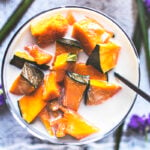
Thai Kabocha Squash in Coconut Milk Dessert
- Total Time: 35 minutes
- Yield: 4 1x
- Diet: Gluten Free
Description
This Thai Kabocha Squash in coconut milk dessert is a delicious sweet treat using just five ingredients. This delicious Thai dessert uses coconut milk and palm sugar for flavoring. It is a light and creamy recipe, perfect for any time of year. Simple and easy Thai dessert!
Ingredients
- 3 cups kabocha squash, cut into 1.5-2 inch long pieces
- 1 can coconut milk, 13.5 oz
- 1 cup water
- ¾ cup palm sugar, shaved into thin, small pieces for quick melting
- ½ tsp salt. Just need a dash to balance out the sweetness. Omit if you have a sweet tooth! (:
Instructions
- Cut the Kabocha squash into 1½-2-inch bite-size pieces. You can leave the skin on as it’s perfectly edible, and that’s how it would be eaten in this traditional Thai dessert.
- Warm up a medium-large pot or saucepan over medium heat, combine the sliced kabocha, coconut milk, and water. Bring the mixture to a gentle boil and cook the squash until tender, about 10-15 minutes. Carefully test with a fork to see if the kabocha is tender enough for eating.
- Add the sugar and salt and gently stir, not to break the squash, until the palm sugar dissolves.
-
Remove from the stove and let cool before serving. This dessert is typically served warm or at room temperature.
Notes
- The squash's skin is typically left on because it gets tender when cooked. The skin helps hold the kabocha's soft and creamy meat together during cooking. You can leave the skin on the squash or peel it off.
- It is best to serve warm or at room temperature. Overnight is fine, too, but know that the squash will get a bit mushy or creamy if used the next day. It's very good, but the squash will become a light puree texture, adding to the dessert's creaminess.
- You can use brown or granulated sugar if you can’t find palm sugar. Know that your dessert will be sweeter if you do not use palm sugar.
- Add crushed ice to the dessert bowl before serving for a chill and fun dessert. This is incredibly refreshing during the summer months.
** Thank you so much for visiting my blog! This is truly a passion for me. If you have enjoyed these recipes and appreciate the hard work I put into them, I would love it if you would share them with your friends! Your recommendation is the highest review I could hope for, and I’d appreciate it! **
- Prep Time: 20
- Cook Time: 15
- Category: Desserts
- Method: Stovetop
- Cuisine: Thai

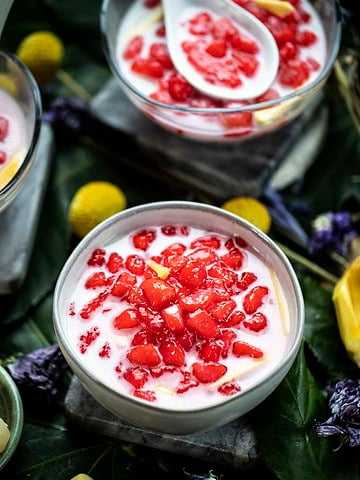
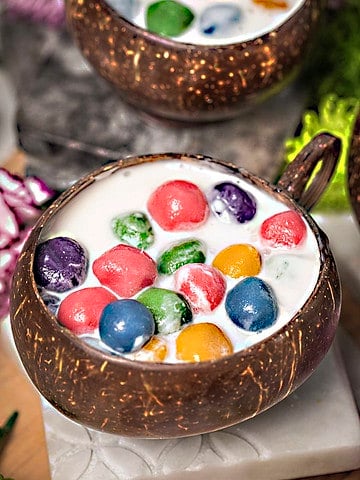
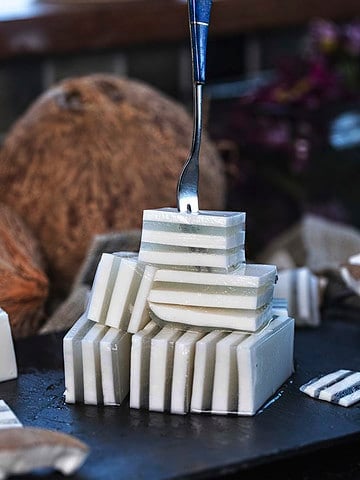
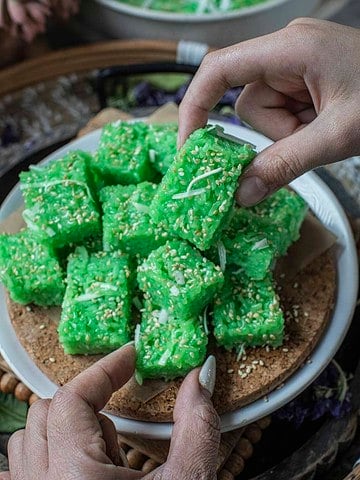
Lisa C
We loved this dish. I liked it hot and my kids liked it cold over ice. The squash is such a sweet flavor, and hold together nicely once cooked.
Stephanie
Perfect timing as Kabocha squash are popping up now! Can’t wait to try this, looks amazing.
Suwanee
Oh, sounds good! Give it a try and please let me know how it turns out! (:
Aunt Sue
Oh this looks so good! Maybe a great use for the extra sweet potatoes I always seem to have around!! (Since you list sweet potato / Japanese sweet potato as a possible substitute.) I love anything with coconut milk. I will let you know when I try it ?